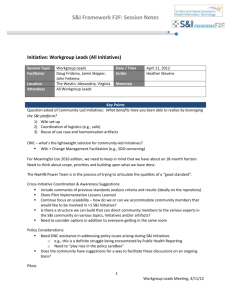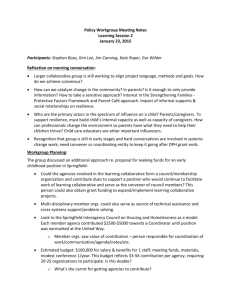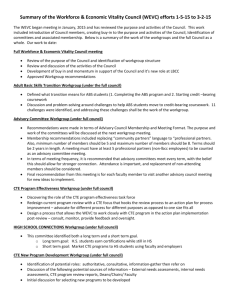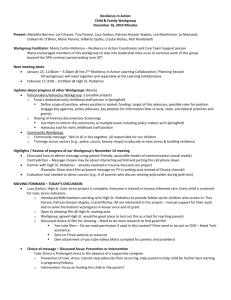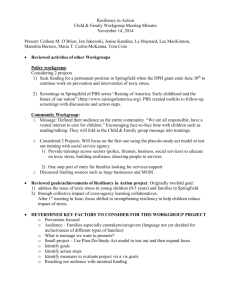Flow Workgroup Meeting Summary 2012 05 Final
advertisement
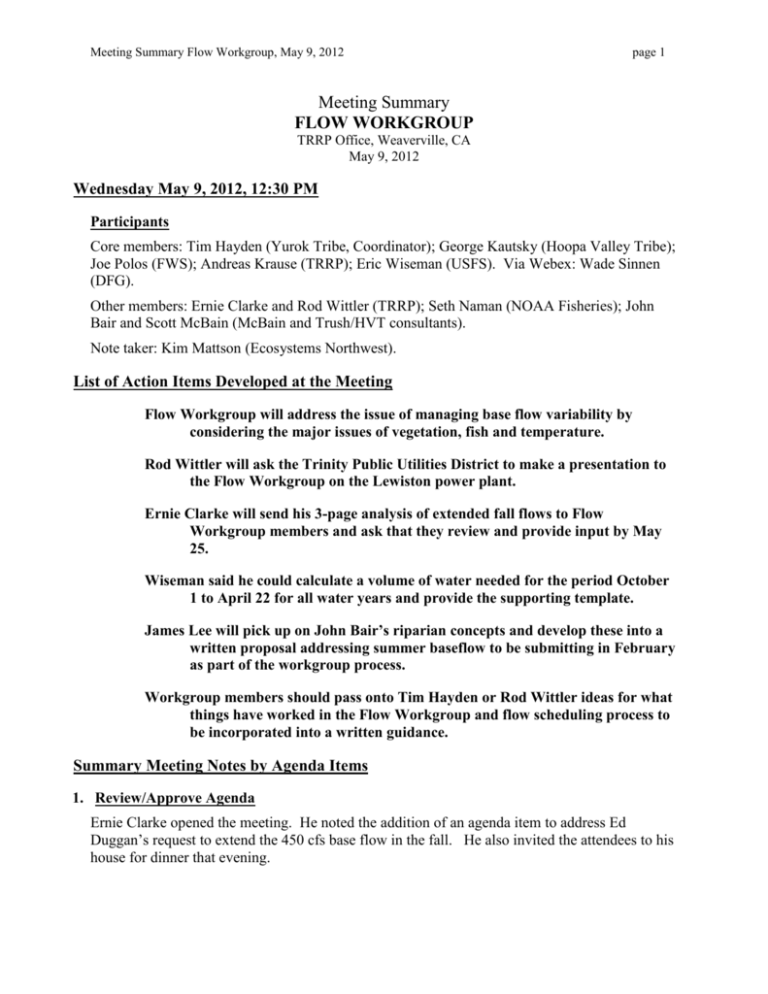
Meeting Summary Flow Workgroup, May 9, 2012 page 1 Meeting Summary FLOW WORKGROUP TRRP Office, Weaverville, CA May 9, 2012 Wednesday May 9, 2012, 12:30 PM Participants Core members: Tim Hayden (Yurok Tribe, Coordinator); George Kautsky (Hoopa Valley Tribe); Joe Polos (FWS); Andreas Krause (TRRP); Eric Wiseman (USFS). Via Webex: Wade Sinnen (DFG). Other members: Ernie Clarke and Rod Wittler (TRRP); Seth Naman (NOAA Fisheries); John Bair and Scott McBain (McBain and Trush/HVT consultants). Note taker: Kim Mattson (Ecosystems Northwest). List of Action Items Developed at the Meeting Flow Workgroup will address the issue of managing base flow variability by considering the major issues of vegetation, fish and temperature. Rod Wittler will ask the Trinity Public Utilities District to make a presentation to the Flow Workgroup on the Lewiston power plant. Ernie Clarke will send his 3-page analysis of extended fall flows to Flow Workgroup members and ask that they review and provide input by May 25. Wiseman said he could calculate a volume of water needed for the period October 1 to April 22 for all water years and provide the supporting template. James Lee will pick up on John Bair’s riparian concepts and develop these into a written proposal addressing summer baseflow to be submitting in February as part of the workgroup process. Workgroup members should pass onto Tim Hayden or Rod Wittler ideas for what things have worked in the Flow Workgroup and flow scheduling process to be incorporated into a written guidance. Summary Meeting Notes by Agenda Items 1. Review/Approve Agenda Ernie Clarke opened the meeting. He noted the addition of an agenda item to address Ed Duggan’s request to extend the 450 cfs base flow in the fall. He also invited the attendees to his house for dinner that evening. Meeting Summary Flow Workgroup, May 9, 2012 page 2 2. Flow Workgroup Admin Items/ Action tracker Ernie Clarke deferred discussion of the Action Tracker to the end of the meeting. 3. Summer Variable Flows John Bair started the discussion on summer variable flow with a set of projected slides. He noted there may be multiple benefits of variable flows but he would talk about effects to riparian vegetation. The base flow period generally runs from July 1 to October 15. He summarized the historic data from the Lewiston flow gage and showed the unimpaired base flow hydrograph has ranged from 50 to 700 cfs. He compared this to the managed base flow (since 1961) that was set at 150 cfs for about a decade, then increased to 300 cfs for another period, and in recent years increased to 450 cfs (across all water-year types). He also noted on natural hydrographs there is variability between years, within the year, and even diurnal variation. He noted the importance of roots to find water for their establishment and growth and that varying hydrographs can affect this process. The Flow Workgroup then entered into a discussion about managing the releases from Lewiston Dam to introduce variability. George Kautsky noted that the base flows in the Trinity downstream of Lewiston, under current conditions, should have some annual variation given that the tributary inputs are not controlled. Bair acknowledged this and wanted to start a discussion about whether they want to manage for more variation. Rod Wittler noted that the need to manage for temperatures may introduce variations. He noted that the new power generator at Lewiston Dam will provide extra ability to manage for cool water releases to the Trinity River. Andreas Krause opined that the management of the constant 450 cfs is the “Achilles Heel” of the program. He noted that a wall of vegetation has formed along the river as a result of the constant baseflow. The high flow release in the spring is the only tool they have to break up the riparian berm. He thinks the constant baseflow enforcing the vegetation line will eventually win out over the high flow attempts to break up the vegetation line. Bair noted that vegetation will be more responsive to the annual variation and that daily variation would have less effect. Scott McBain noted that in the past, the temperature targets of specific levels and at specific locations constrained options for varying flow. He asked if the Workgroup was willing to take up the discussion of modification of the temperature criteria. It was clarified that Trinity Public Utilities District will own the new generation facility on Lewiston Dam, they have a FERC license, and may have some expectations of minimum flows needed for power generation. There was more discussion about the temperature needs, the timing of the changes, and the stage changes (e.g., duration, frequency, and magnitude). It was noted they needed cool water for juvenile coho in the summer and also for egg viability in the winter. Seth Naman noted that 60 F is about the maximum that coho can readily utilize. Wittler noted that egg mortality increases rapidly at about 57 F. Aaron Martin noted that vegetation growing lower to the water’s edge can provide habitat for juveniles. Andreas Krause thought that coming up with new ways to manage flow for vegetation will be a difficult “nut to crack,” given the temperature and fish issues that must also be addressed. Krause noted that the main objective for today would be whether they want to take on this issue and to begin to find ways to resolve it. There was general agreement that increases in variation would be good. Seth Naman asked what sort of stage change might be used to allow vegetation to establish lower on the water’s edge. McBain noted that since the earlier management releases Meeting Summary Flow Workgroup, May 9, 2012 page 3 used 150 and 300 cfs, this could be the data to look at this question. McBain asked if one varied flow on a weekly time step (e.g., to manage for weekly changes in weather and air temperature), would the vegetation respond. Bair thought that varying water flows over longer periods such as 24 days may have a bigger effect on plants. He acknowledged that fish and temperature needs may be the bigger drivers for base flow. Wittler noted that the highest river temperatures occur in late July, but most temperature threshold exceedances occur later in the year when the criteria switches from 60 F to 56 F (when egg incubation needs to be met). He said they have problems deciding on the source of water needed to keep river temperatures below these thresholds. Tim Hayden asked that they summarize the discussion. Bair said he needs to know if the Workgroup wants to take on this issue. Hayden reiterated that the issue seems to be clearly yes based on the vegetation, fish and temperature standpoints. Hayden next asked the core members if they were in consensus to take on this issue and they responded that they were. Action item: Flow Workgroup will address the issue of managing base flow variability by considering the major issues of vegetation, fish and temperature. Action item: Rod Wittler will ask the Trinity Public Utilities District to make a presentation to the Flow Workgroup on the Lewiston power plant. Scott McBain asked if this effort would begin a discussion of the temperature criteria and this may be beyond the purview of the Flow Workgroup. Wittler said they can model this. Ernie Clarke suggested that the discussion is still somewhat vague and suggested that someone should summarize this out in a written plan. The Workgroup thought they can take this up after Eric Wiseman’s presentation. Break 4. Fall/Winter Variable Flows Ernie Clarke summarized a request by Ed Duggan to the TAMWG to keep Lewiston fall base flows at 450 cfs (e.g., do not drop to 300 cfs) until the fall rains begin to arrive. Clarke had prepared a fact sheet and he said he would send this out to the Workgroup members. Clarke prepared a set of calculations to show what percent of the restoration allocation would be needed to maintain the higher flow for 14, 28, or 42 days. Seth Naman noted that the use of percent of annual flow may underestimate the effects since the percentages were low (e.g., < 2 %). He noted that still outstanding was the discussion of how this extension of flow would impact the ability to meet ROD objectives. Action item: Ernie Clarke will send his 3-page analysis of extended fall flows to Flow Workgroup members and ask that they review and provide input by May 25. Eric Wiseman next presented a Powerpoint entitled “2013 Trinity River Flow Schedule Modification Proposal.” He presented his proposed modified hydrographs for the five water years. He noted each is ROD neutral. He made a set of modifications to the current hydrograph that would more closely match what streams naturally do. He explained his rationale as a more Meeting Summary Flow Workgroup, May 9, 2012 page 4 closely matched natural hydrograph would provide better cues to the fish and other aquatic organisms. He proposed fall flow to increase from 400 up to 450 as opposed to the current practice of dropping fall base flows from 450 down to 300 cfs. He next proposed to slowly increase flows over the winter. This concept raised questions about what would happen if the year turned out to be critically dry. He countered that the winter flows were not much of the total water budget and any additional amount used in winter could be made up later during the larger spring releases. Wiseman next moved to the spring high flow and asked why the various water years do not peak at the same time. Various Workgroup members explained the rationale as years with lower snow seem to melt faster and therefore peak sooner. Also in a drier year, the earlier peak helps to push the fish out quicker. Wiseman projected his proposed peak flows for the group. His proposed flows had two-day peak flows and all occurred at the same date of May 7. For the Critical Dry year, he proposed no peak but a more flat period of flow at 900 cfs. For an Extremely Wet year he proposed a peak of 10,700 cfs. He justified the May 7 peak date by showing the 54-years of record of flow on the Upper Trinity River above Coffee Creek and the 8-years of flow records available for Rush Creek that peaked on average on May 7. Scott McBain suggested that if he broke out the flows by water year, he may get the more staggered peaks as used by the ROD. McBain said he still has the files that predicted the peaks using data up to 1994 but would really like to have Wiseman update these files with more recent data to see if the peaks were shifted (due to climate change). McBain agreed to send Wiseman the files for updating. Wiseman showed the flow data from the Upper Trinity River above Coffee Creek and Rush Creek that demonstrated daily variation. He noted the current hydrograph does not include this. He believed that diurnal fluctuation will increase and decrease shear stresses and may act to create more geomorphic work. He cited his time on the river while fishing and that he noticed that most of the sediment transport occurs during the first couple of days of high flows. He summarized that he is calling for: Increases in fall flows, Early spring increases based on inflow exceedance predictions, Earlier peak flows of shorter duration, Diurnal flow fluctuations, A 0.1 ft/day descent rate, A 1.5 month period of decreased late summer and early fall (until 10/15) base flow. Tim Hayden noted there are processes within the flow scheduling to consider many of Wiseman’s proposals. But he thought there was not an easy way to account for the extra water needed to meet the winter increases. Rod Wittler noted that Wiseman made some cogent proposals and the flow decision process could be changed in order to address them. Wittler pointed out that Wiseman’s proposal to use water to slowly increase winter flows would need to be account for the water in the upcoming year and that this was a novel idea. Ernie Clarke thought the presentation could be written up addressing some of the uncertainties so that it could be better advanced. He was worried that in 6 months, they would be discussing the same points over again. Wiseman said he had hoped he could propose modified fall flows starting this October 1. It was pointed out that the normally flow scheduling process does not normally address October to April flows and instead entertains flow proposals in spring and these mainly Meeting Summary Flow Workgroup, May 9, 2012 page 5 address the peak flows. John Bair suggested Wiseman show how that water would be used from the spring peaks. Joe Polos said that the proposed schedules would have to be evaluated in the context of the objectives that the various components of the ROD hydrographs are designed to meet. This would include providing suitable amounts of habitat, meeting temperature objectives, meeting riparian objectives, and meeting fluvial geomorphic objectives. Action item: Wiseman said he could calculate a volume of water needed for the period October 1 to April 22 for all water years and provide the supporting template. Action item: James Lee will pick up on John Bair’s riparian concepts and develop these into a written proposal addressing summer baseflow to be submitting in February as part of the workgroup process. 5. Next steps/ review of Action Items Action item: Workgroup members should pass onto Tim Hayden or Rod Wittler ideas for what things have worked in the Flow Workgroup and flow scheduling process to be incorporated into a written guidance. Adjourn 4:10 PM Meeting Summary Flow Workgroup, May 9, 2012 page 6 May 9, 2012 DRAFT Version Date 5-9-12 12:30 PM Flow Workgroup Meeting Agenda TRRP Large Conference Room, Weaverville Tim Hayden Coordinators: Rod Wittler Desired Outcome: Initial discussions of summer/winter adaptive management flow experiments/adaptations Please read/review: Flow Scheduler spreadsheet Flow Alternatives Template GoTo Meeting Information Please bring: Concepts for Summer and Winter variable flow alternatives Draft summer and winter flow schedule alternatives and supporting rationale Agenda Items Time Topic Presenter 2012 Flow Scheduling 12:30 Review/Approve Agenda Tim Hayden 12:40 Flow Workgroup Admin Items/ Action tracker Tim Hayden Ernie Clarke 12:45 Summer Variable Flows 2:00 Break 2:30 Fall/Winter Variable Flows 3:45 Next steps/ review of Action Items Tim Hayden 4:00 Adjourn Tim Hayden John Bair Eric Wiseman
